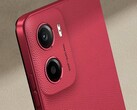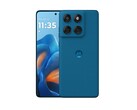Verdict
While the Razr 50 made a real leap with its large external display, the Razr 60 only takes small steps forward: A little more power, a slightly larger battery with slightly longer runtimes, a slightly brighter screen, and slightly faster Wi-Fi.
So there's no real killer argument as to why you shouldn't go for the predecessor. Unless, of course, you really want the new color variants, which are actually very pretty.
It is pleasing that Motorola has reduced the price of its cheaper flip phone by 100 Euros (~$115) in times of inflation fears. However, four years of security and system updates are only mediocre.
On its own, the Motorola Razr 60 is still an unusual smartphone that will delight design fans and photo enthusiasts: thanks to the hinge and the external display, you can also take selfies with the main camera or set up the phone without a tripod.
However, other flip phones often offer even more power and slightly better cameras. In view of the comparatively low price, the Razr 60 is nevertheless a recommendation for anyone who is enthusiastic about the concept and doesn't want to spend too much money.
Pros
Cons
Price and availability
The manufacturer wants 799 Euros (~$921) for its smartphone in its online store.
However, other retailers such as alza.de already offer the phone with a 100 Euro (~$115) discount.
Table of Contents
- Verdict
- Specifications
- Case and features - still stable
- Communication and operation - WiFi 6E and fast touchscreen
- Software and sustainability - Motorola with 4 years of updates
- Cameras - Hardly any changes to the predecessor
- Display - Slightly brighter, but slower
- Performance, emissions and battery life - fast enough for everyday use
- Notebookcheck overall rating
- Possible alternatives in comparison
Specifications
Case and features - still stable
With the Razr 60, Motorola is launching an update for its relatively inexpensive flip phone. You can open it up at the short side and then get a huge inner display in addition to the already large outer display. At first glance, it is difficult to distinguish it from its predecessor, as nothing has changed in terms of appearance, dimensions and weight.
But wait - that's not quite true, because if you know what colors and materials were available last year, Motorola 2025 presents completely new variants: The dark blue Gibraltar Sea, for example, with a nylon back, the light beige Lightest Sky with an acetate finish or, like our test device, in a leather look in the light green Spring Bud. All colors are selected from the Pantone palette.
The Motorola Razr 60 is once again a feast for design fans and can also bring color into everyday life if desired. The titanium-reinforced hinge and the barely visible and barely noticeable crease in the main display make the phone easy to use in many situations. The workmanship appears sturdy, but the chassis creaks quietly when twisted.
Thanks to IP48 protection, the phone can also be taken into shallow water.
8 GB RAM and 256 GB mass storage is the only available memory configuration. Dual SIM operation is also possible thanks to nano and eSIM support.
Communication and operation - WiFi 6E and fast touchscreen
WiFi 6E is also on board the Razr 60 and thus support for the little-used 6 GHz network in the WLAN. This allows the phone to achieve quite decent speeds of around 700 - 1,000 MBit/s.
There are so many LTE and 5G frequencies available that the phone is also well-suited for frequent travelers.
Thanks to the 300 Hz sampling rate, touch inputs on the inner display are captured without any problems; the outer display also reacts quickly with a 120 Hz sampling rate, but is sometimes a little less precise.
The fingerprint sensor is integrated into the standby button on the right and unlocks the phone very quickly and reliably. Unlocking using facial recognition is possible via the cameras on the inside and outside.
| Networking | |
| Motorola Razr 60 | |
| iperf3 transmit AXE11000 6GHz | |
| iperf3 receive AXE11000 6GHz | |
| Motorola Razr 50 | |
| iperf3 transmit AXE11000 6GHz | |
| iperf3 receive AXE11000 6GHz | |
| Samsung Galaxy Z Flip6 5G | |
| iperf3 transmit AXE11000 | |
| iperf3 receive AXE11000 | |
| iperf3 transmit AXE11000 6GHz | |
| iperf3 receive AXE11000 6GHz | |
| Xiaomi Mix Flip | |
| iperf3 transmit AXE11000 | |
| iperf3 receive AXE11000 | |
| Honor Magic V Flip | |
| iperf3 transmit AXE11000 | |
| iperf3 receive AXE11000 | |
| Average Wi-Fi 6E | |
| iperf3 transmit AXE11000 | |
| iperf3 receive AXE11000 | |
| iperf3 transmit AXE11000 6GHz | |
| iperf3 receive AXE11000 6GHz | |
| Average of class Smartphone | |
| iperf3 transmit AXE11000 | |
| iperf3 receive AXE11000 | |
| iperf3 transmit AXE11000 6GHz | |
| iperf3 receive AXE11000 6GHz | |
Software and sustainability - Motorola with 4 years of updates
Android 15 is pre-installed, manufacturer-specific changes are outsourced to apps so that they can be updated more easily. There are many AI functions in the system, for example notifications are summarized on request or images are created and improved.
The phone will receive updates until June 2029, i.e. four years. Samsung offers 7 years here and is therefore still unbeaten.
The packaging is only printed in one color and does not use any plastics. We were unable to find any information about the device's CO2 footprint.
Cameras - Hardly any changes to the predecessor
If you compare the camera equipment of the Razr 60 with its predecessor, no changes are visible: there is still a 50-megapixel sensor as the main camera and a 13-megapixel wide-angle lens.
The image quality of the main camera cannot keep up with conventional high-end phones. The pictures are usable, but usually a little grainy and the edges fray. In very low light and with high contrasts, decent photos can be taken.
The wide-angle camera also takes nice snapshots, but they are too coarse in detail.
Inside there is a 32-megapixel camera for selfies, which are passable but not bright enough in dark areas.
Image comparison
Choose a scene and navigate within the first image. One click changes the position on touchscreens. One click on the zoomed-in image opens the original in a new window. The first image shows the scaled photograph of the test device.
Main camera PlantMain camera EnvironmentMain camera Low LightWide-angle camera

Display - Slightly brighter, but slower
There is also no further development of the screens, rather the opposite: the maximum 165 Hz of the main display on the Razr 50 has been reduced to 120 Hz on the current model and the external display shows a maximum of 90 frames per second. However, hardly anyone will really notice the difference in everyday use.
Motorola has optimized the brightness in everyday use a little, otherwise the measured values of the main displays on the Razr 50 and Razr 60 are quite similar. The color reproduction is very good.
PWM flickering is to be expected, but at a very high rate of 764 Hz at low brightness (probably due to DC dimming). This should hardly cause any problems, even for sensitive people.
| |||||||||||||||||||||||||
Brightness Distribution: 94 %
Center on Battery: 1185 cd/m²
Contrast: ∞:1 (Black: 0 cd/m²)
ΔE ColorChecker Calman: 1.31 | ∀{0.5-29.43 Ø4.78}
ΔE Greyscale Calman: 1.5 | ∀{0.09-98 Ø5}
99.6% sRGB (Calman 2D)
Gamma: 2.133
CCT: 6382 K
| Motorola Razr 60 P-OLED, 2640x1080, 6.9" | Motorola Razr 50 P-OLED, 2640x1080, 6.9" | Samsung Galaxy Z Flip6 5G Dynamic AMOLED 2X, 2640x1080, 6.7" | Xiaomi Mix Flip AMOLED, 2912x1224, 6.9" | Honor Magic V Flip OLED, 2520x1080, 6.8" | |
|---|---|---|---|---|---|
| Screen | -7% | -49% | -77% | 8% | |
| Brightness middle (cd/m²) | 1185 | 1116 -6% | 1210 2% | 949 -20% | 1529 29% |
| Brightness (cd/m²) | 1178 | 1122 -5% | 1221 4% | 949 -19% | 1535 30% |
| Brightness Distribution (%) | 94 | 97 3% | 98 4% | 98 4% | 97 3% |
| Black Level * (cd/m²) | |||||
| Colorchecker dE 2000 * | 1.31 | 1.02 22% | 3.1 -137% | 2.1 -60% | 1.3 1% |
| Colorchecker dE 2000 max. * | 1.78 | 2.54 -43% | 4.2 -136% | 5.6 -215% | 2.1 -18% |
| Greyscale dE 2000 * | 1.5 | 1.7 -13% | 2 -33% | 3.8 -153% | 1.5 -0% |
| Gamma | 2.133 103% | 2.123 104% | 2.05 107% | 2.25 98% | 2.22 99% |
| CCT | 6382 102% | 6510 100% | 6666 98% | 6826 95% | 6303 103% |
* ... smaller is better
Screen Flickering / PWM (Pulse-Width Modulation)
| Screen flickering / PWM detected | 764.3 Hz Amplitude: 74 % | ||
The display backlight flickers at 764.3 Hz (worst case, e.g., utilizing PWM) . The frequency of 764.3 Hz is quite high, so most users sensitive to PWM should not notice any flickering. In comparison: 53 % of all tested devices do not use PWM to dim the display. If PWM was detected, an average of 8111 (minimum: 5 - maximum: 343500) Hz was measured. | |||
Measurement series with fixed zoom level and different brightness settings (The amplitude curve at minimum brightness looks flat, but this is due to the scaling. The info box shows the enlarged version of the amplitude at minimum brightness)
Display Response Times
| ↔ Response Time Black to White | ||
|---|---|---|
| 1.9 ms ... rise ↗ and fall ↘ combined | ↗ 0.9 ms rise | |
| ↘ 1 ms fall | ||
| The screen shows very fast response rates in our tests and should be very well suited for fast-paced gaming. In comparison, all tested devices range from 0.1 (minimum) to 240 (maximum) ms. » 9 % of all devices are better. This means that the measured response time is better than the average of all tested devices (20.2 ms). | ||
| ↔ Response Time 50% Grey to 80% Grey | ||
| 12.8 ms ... rise ↗ and fall ↘ combined | ↗ 0.9 ms rise | |
| ↘ 11.9 ms fall | ||
| The screen shows good response rates in our tests, but may be too slow for competitive gamers. In comparison, all tested devices range from 0.165 (minimum) to 636 (maximum) ms. » 25 % of all devices are better. This means that the measured response time is better than the average of all tested devices (31.6 ms). | ||
Performance, emissions and battery life - fast enough for everyday use
With the MediaTek Dimensity 7400X soC, the Razr 60 offers slightly more power than its predecessor, but the difference should hardly be noticeable in everyday use. Compared to more expensive flip phones, the performance is significantly lower, but it is usually sufficient for smooth operation.
There is a noticeable warming after a very long load, but this is not critical. At the same time, there is hardly any visible loss of SoC performance in the stress tests.
The speaker is supported by the earpiece during sound playback. The duo is not as loud, but sounds quite decent. There are also many wireless audio codecs for connecting headphones or speakers.
The battery life is slightly longer than its predecessor thanks to the more powerful battery. However, other flip phones last significantly longer than the 13:34 hours we measured with the Razr 60 in our Wi-Fi test.
| Geekbench AI | |
| Single Precision NPU 1.5 | |
| Average of class Smartphone (80 - 5210, n=58, last 2 years) | |
| Motorola Razr 60 | |
| Average MediaTek Dimensity 7400X (569 - 575, n=3) | |
| Half Precision NPU 1.5 | |
| Average of class Smartphone (80 - 36297, n=58, last 2 years) | |
| Motorola Razr 60 | |
| Average MediaTek Dimensity 7400X (1311 - 1389, n=3) | |
| Quantized NPU 1.5 | |
| Average of class Smartphone (133 - 49889, n=58, last 2 years) | |
| Motorola Razr 60 | |
| Average MediaTek Dimensity 7400X (2689 - 2852, n=3) | |
| Motorola Razr 60 | Motorola Razr 50 | Samsung Galaxy Z Flip6 5G | Xiaomi Mix Flip | Honor Magic V Flip | Average 256 GB UFS 2.2 Flash | Average of class Smartphone | |
|---|---|---|---|---|---|---|---|
| AndroBench 3-5 | -2% | 127% | 177% | 46% | -15% | 62% | |
| Sequential Read 256KB (MB/s) | 1020.1 | 989.1 -3% | 3930.68 285% | 4063.4 298% | 1947.4 91% | 903 ? -11% | 2222 ? 118% |
| Sequential Write 256KB (MB/s) | 918.4 | 837.3 -9% | 2603.84 184% | 3332.67 263% | 1672.06 82% | 727 ? -21% | 1841 ? 100% |
| Random Read 4KB (MB/s) | 266.2 | 284.4 7% | 445.5 67% | 367.24 38% | 277.55 4% | 226 ? -15% | 294 ? 10% |
| Random Write 4KB (MB/s) | 282.9 | 276.8 -2% | 202.97 -28% | 587.21 108% | 297.97 5% | 247 ? -13% | 334 ? 18% |
(-) The maximum temperature on the upper side is 45.1 °C / 113 F, compared to the average of 35.2 °C / 95 F, ranging from 21.9 to 247 °C for the class Smartphone.
(±) The bottom heats up to a maximum of 41.3 °C / 106 F, compared to the average of 34 °C / 93 F
(+) In idle usage, the average temperature for the upper side is 26.5 °C / 80 F, compared to the device average of 32.9 °C / 91 F.
3DMark Steel Nomad Stress Test
| 3DMark | |
| Wild Life Stress Test Stability | |
| Motorola Razr 50 | |
| Motorola Razr 60 | |
| Honor Magic V Flip | |
| Xiaomi Mix Flip | |
| Samsung Galaxy Z Flip6 5G | |
| Wild Life Extreme Stress Test | |
| Motorola Razr 50 | |
| Motorola Razr 60 | |
| Xiaomi Mix Flip | |
| Honor Magic V Flip | |
| Samsung Galaxy Z Flip6 5G | |
Motorola Razr 60 audio analysis
(+) | speakers can play relatively loud (85.8 dB)
Bass 100 - 315 Hz
(-) | nearly no bass - on average 21.5% lower than median
(±) | linearity of bass is average (11.8% delta to prev. frequency)
Mids 400 - 2000 Hz
(+) | balanced mids - only 3.9% away from median
(+) | mids are linear (5.2% delta to prev. frequency)
Highs 2 - 16 kHz
(±) | higher highs - on average 6.6% higher than median
(+) | highs are linear (5.4% delta to prev. frequency)
Overall 100 - 16.000 Hz
(±) | linearity of overall sound is average (20.5% difference to median)
Compared to same class
» 35% of all tested devices in this class were better, 9% similar, 56% worse
» The best had a delta of 11%, average was 35%, worst was 134%
Compared to all devices tested
» 53% of all tested devices were better, 8% similar, 39% worse
» The best had a delta of 4%, average was 24%, worst was 134%
Samsung Galaxy Z Flip6 5G audio analysis
(+) | speakers can play relatively loud (90.8 dB)
Bass 100 - 315 Hz
(-) | nearly no bass - on average 24.7% lower than median
(±) | linearity of bass is average (7.5% delta to prev. frequency)
Mids 400 - 2000 Hz
(±) | reduced mids - on average 5.3% lower than median
(+) | mids are linear (5.3% delta to prev. frequency)
Highs 2 - 16 kHz
(+) | balanced highs - only 4.2% away from median
(+) | highs are linear (3.5% delta to prev. frequency)
Overall 100 - 16.000 Hz
(±) | linearity of overall sound is average (17.4% difference to median)
Compared to same class
» 12% of all tested devices in this class were better, 8% similar, 80% worse
» The best had a delta of 11%, average was 35%, worst was 134%
Compared to all devices tested
» 32% of all tested devices were better, 8% similar, 60% worse
» The best had a delta of 4%, average was 24%, worst was 134%
| Motorola Razr 60 4500 mAh | Motorola Razr 50 4200 mAh | Samsung Galaxy Z Flip6 5G 4000 mAh | Xiaomi Mix Flip 4780 mAh | Honor Magic V Flip 4800 mAh | |
|---|---|---|---|---|---|
| Battery runtime | -5% | 14% | 10% | 42% | |
| WiFi v1.3 (h) | 13.6 | 12.9 -5% | 15.5 14% | 14.9 10% | 19.3 42% |
| Reader / Idle (h) | 24.6 | 33.3 | 31 | ||
| H.264 (h) | 16.6 | 19.1 | 22.9 | ||
| Load (h) | 4.8 | 4.1 | 4.5 |
Notebookcheck overall rating
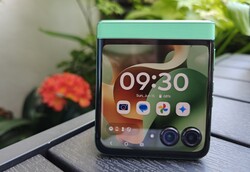
The Razr 60 is comparatively inexpensive and therefore has a special status among flip phones.
At the same time, little has changed compared to its predecessor and that leaves an opportunity to pick up the Razr 50 at a reasonable price.
Motorola Razr 60
- 06/15/2025 v8
Florian Schmitt
Possible alternatives in comparison
Image | Model / Review | Price | Weight | Drive | Display |
|---|---|---|---|---|---|
| Motorola Razr 60 MediaTek Dimensity 7400X ⎘ ARM Mali-G615 MP2 ⎘ 8 GB Memory, 256 GB UFS 2.1 | Amazon: $599.99 List Price: 799€ | 188 g | 256 GB UFS 2.2 Flash | 6.90" 2640x1080 413 PPI P-OLED | |
| Motorola Razr 50 MediaTek Dimensity 7300X ⎘ ARM Mali-G615 MP2 ⎘ 8 GB Memory, 256 GB UFS 2.1 | Amazon: 1. $699.99 Motorola Razr+ 2025 | Unlock... 2. $584.99 Motorola razr+ | 2024 | Unlo... 3. $899.99 Motorola Razr Ultra 2025 | U... List Price: 899€ | 188 g | 256 GB UFS 2.2 Flash | 6.90" 2640x1080 413 PPI P-OLED | |
| Samsung Galaxy Z Flip6 5G Qualcomm Snapdragon 8 Gen 3 for Galaxy ⎘ Qualcomm Adreno 750 ⎘ 12 GB Memory, 512 GB | Amazon: $849.97 List Price: 1319€ | 187 g | 512 GB UFS 4.0 Flash | 6.70" 2640x1080 426 PPI Dynamic AMOLED 2X | |
| Xiaomi Mix Flip Qualcomm Snapdragon 8 Gen 3 ⎘ Qualcomm Adreno 750 ⎘ 12 GB Memory, 256 GB | Amazon: 1. $368.00 JayTong Foldable LCD Replace... 2. $8.99 QWFORQW [2+2 Pack for Xiaomi... 3. $8.99 QWFORQW [2+2 Pack for Xiaomi... List Price: 1299€ | 190 g | 256 GB UFS 4.0 Flash | 6.86" 2912x1224 460 PPI AMOLED | |
| Honor Magic V Flip Qualcomm Snapdragon 8+ Gen 1 ⎘ Qualcomm Adreno 730 ⎘ 12 GB Memory, 512 GB | Amazon: 1. $19.95 BoxWave Screen Protector Com... 2. $9.99 YOUULAR [1 Pack Privacy Scre... 3. $14.99 YOUULAR [2 Pack Screen Prote... | 193 g | 512 GB UFS 3.1 Flash | 6.80" 2520x1080 403 PPI OLED |
Transparency
The selection of devices to be reviewed is made by our editorial team. The test sample was provided to the author as a loan by the manufacturer or retailer for the purpose of this review. The lender had no influence on this review, nor did the manufacturer receive a copy of this review before publication. There was no obligation to publish this review. As an independent media company, Notebookcheck is not subjected to the authority of manufacturers, retailers or publishers.
This is how Notebookcheck is testing
Every year, Notebookcheck independently reviews hundreds of laptops and smartphones using standardized procedures to ensure that all results are comparable. We have continuously developed our test methods for around 20 years and set industry standards in the process. In our test labs, high-quality measuring equipment is utilized by experienced technicians and editors. These tests involve a multi-stage validation process. Our complex rating system is based on hundreds of well-founded measurements and benchmarks, which maintains objectivity. Further information on our test methods can be found here.






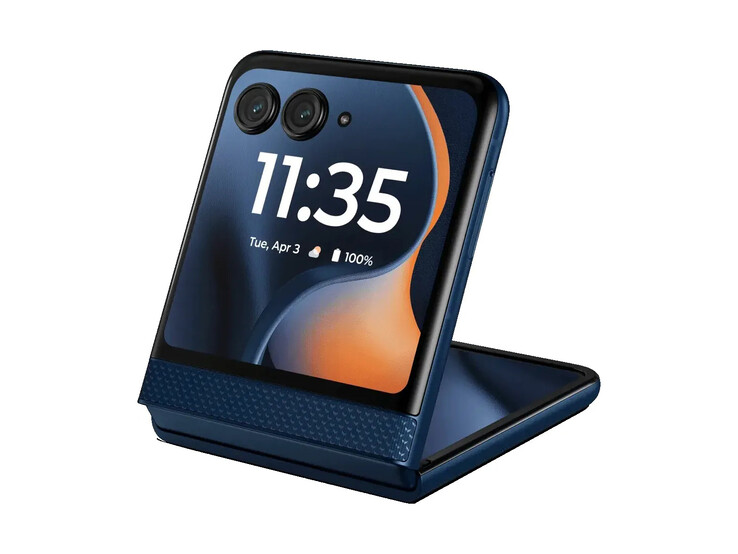











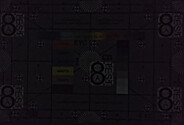

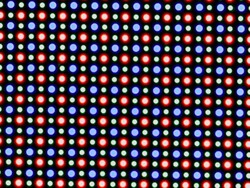







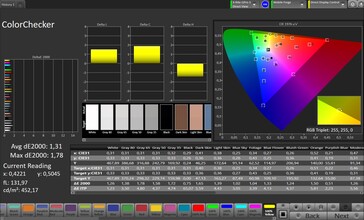
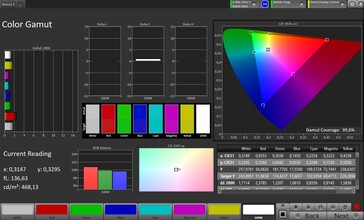
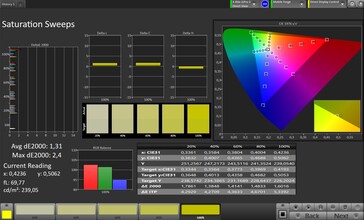
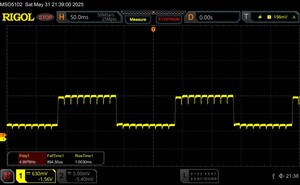
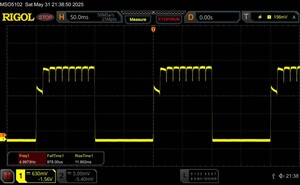
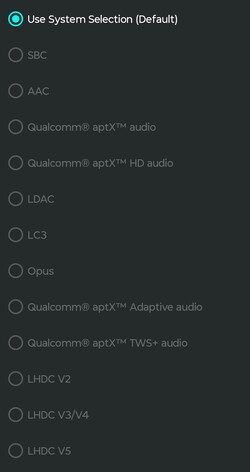
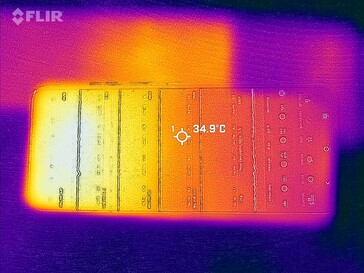

 Total Sustainability Score:
Total Sustainability Score: 




